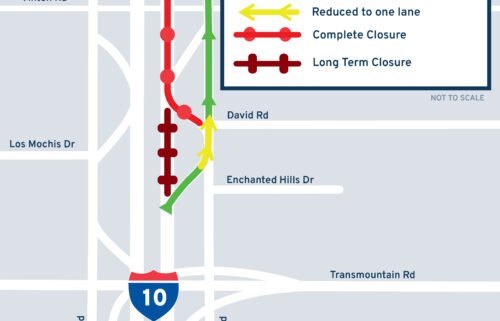‘Bursting at the seams’: Full ICUs are creating a dangerous ER backlog and forcing hospitals to cancel surgeries
CNN, KEYE
By Christina Maxouris, CNN
Michael Kagan, a professor at the University of Nevada, Las Vegas, says the cancerous lymph nodes in his neck are like a “ticking time bomb.” But there’s little he can do.
MountainView Hospital, where he was scheduled to have his procedure last week, has put all surgeries requiring an overnight stay on hold as Covid-19 case counts and hospitalizations climb, according to a statement from spokesperson Jennifer McDonnell.
“I’m not getting any treatment so on any given day it could spread to another part of my body or it can grow and cause a much bigger problem,” Kagan told CNN’s Brianna Keilar on Tuesday. “I’m just living with a time bomb and I’m just letting it tick down, basically.”
With Covid-19 case numbers surging across the United States and many unvaccinated Americans falling ill, the number of available hospital beds has been dwindling in parts of the country. Some hospitals now report their intensive care units, which are usually reserved for the most critically ill patients, are full — a grim reality that’s forcing health care leaders to make tough decisions, whether that be redirecting new patients to other facilities, canceling surgeries or creating makeshift ICU beds in the middle of emergency rooms.
“It’s a nightmare,” said Dr. Teri Dyess, director of hospital medicine at St. Dominic Hospital in Jackson, Mississippi. “We’ve had people drive here (from) three hours away for their planned surgery and we have no beds to put them in after they operate.”
Mississippi broke its Covid-19 hospitalization record Thursday, with more than 1,490 patients statewide, according to state data. Roughly 388 of those are in ICUs. A day earlier, state epidemiologist Dr. Paul Byers warned the minimal available ICU capacity meant dozens of patients are waiting in emergency rooms for an ICU bed. Mississippians should not be surprised if they get sick and end up in a hospital 200 miles away because it’s the only facility with availability, state health officer Dr. Thomas Dobbs added.
Hospitals are creating makeshift intensive care units
At Jackson’s Mississippi Baptist Medical Center, pulmonologist Dr. Maria Rappai said Wednesday there are roughly 18 ventilated Covid-19 patients in the hospital’s ICU and “we have several in the emergency room” who are waiting to go into intensive care. Their ICU usually gets patients from across the state who may have pneumonia or sepsis or who have suffered heart attacks and need services such as life support.
They have so many ICU patients that their emergency room is now functioning as an intensive care unit, Rappai said.
“We may be using an ER room as an ICU, which then delays the person who comes to the emergency room with a broken arm, because you have to wait to get into a room to be seen,” Rappai said. “It’s a tough situation.”
In the nearby hospital where Dyess works — where the intensive care unit usually treats complicated stroke patients from across the state — ICU patients are also spilling over into the emergency room. To keep more ICU beds available, the hospital has had to put off surgeries that require overnight stays, including hip and knee surgeries for patients who are “severely crippled with arthritic conditions,” she said.
“One of our cardiologists couldn’t even get one of his own patients here that was having a heart attack. They had to send him to another hospital that was able to take him,” Dyess said.
This week, the hospital didn’t have room to accommodate a cancer patient who needed treatment that required an overnight stay, Dyess said. The patient, desperate to finally get the procedure, told hospital officials he would lie on the floor if he had to, Dyess said.
Hospitals across the country are facing similar problems: In North Carolina, health officials announced Tuesday the state had seen its largest single-day jump in ICU admissions since the pandemic’s start — and Covid-19 ICU patients made up more than a quarter of hospitalized Covid-19 patients in the state.
“These high-levels of COVID-related admissions jeopardize the ability of our hospitals to provide needed care in our communities,” Kody Kinsley, the chief deputy secretary for health at the state’s Department of Health and Human Services, said in a statement. The vast majority of those patients, Kinsley added, are unvaccinated.
In Nashville, Tennessee, the Vanderbilt University Medical Center’s adult hospital and emergency department were “completely full,” the center said Friday, adding it was limiting elective cases and declining transfers from many hospitals.
Dallas County, Texas, Judge Clay Jenkins said Friday there were “zero ICU beds left for children.”
“That means if your child’s in a car wreck, if your child has a congenital heart defect or something and needs an ICU bed, or more likely if they have Covid and need an ICU bed, we don’t have one. Your child will wait for another child to die,” Jenkins said.
Full ICUs are creating a dangerous ER backlog
The makeshift ICU beds in ERs are contributing to a backlog and adding hours to wait times for patients.
“Wait times have been up to 12 hours for patients to see physicians and get care in the ER,” said Dr. Alan Brown, the chief medical officer at the Southeast Georgia Health System, in the state’s southern coastal corner. “Our ability to take care of patients that are ill from things other than Covid is really hindered by the fact that we’re so overwhelmed.”
The hospital reported more than 130 Covid-19 patients Wednesday, according to Brown — far higher than its previous record of 98 patients during the previous surge. He said hospital officials don’t think they’re nearing their peak any time soon.
The hospital’s ICU would normally be treating patients with sepsis, heart failures or heart attacks or surgical patients, Brown said. But Covid-19 patients — more than 90% of whom are unvaccinated, he said — now far outpace any other cases, he added. Elective surgeries and endoscopies have been canceled, he added, to make space and pull more staff toward patients with the virus.
“We desperately needed the nursing support because our ICUs are so inundated with critically ill Covid patients,” Brown said.
“It really just is bursting at the seams,” he said.
Announcing a mask mandate that went into effect Friday, Oregon Gov. Kate Brown said earlier in the week that Covid-19 hospitalizations were at a “record high” and ICU beds statewide were 90% full.
“Some of our hospital regions have fewer than five ICU beds available to start the day,” she said. “Without safety measures, we could be as many as 500 staffed hospital beds short of what we need to treat patients by September and that’s patients coming into the hospital for any reason: Covid, a heart attack or a car accident.”
On Friday, Brown announced the state will begin deploying up to 1,500 Oregon National Guard members next week to support hospitals dealing with a surge of Covid-19 patients.
Ambulances are waiting outside hospitals
In some parts of the United States, the backlog from ICUs is so bad, ambulances are lining up outside facilities.
“You’ll have an ambulance that will bring a Covid patient in, or some other medical emergency, and if they do not have ICU space, then they have to wait,” Arkansas Gov. Asa Hutchinson said in a news conference Tuesday. Just a day earlier, the state reported only eight ICU beds were available. “And that’s the problem, because if an ambulance waits for four or five hours for space to free up, then they can’t respond to other emergencies. So all you can do is wait until a bed becomes available.”
While medical staff will take care of patients, Hutchinson said, the level of care wouldn’t be the same as an ICU, which usually has more specialized equipment and nurses tending to patients more frequently.
In Houston, fire department chief Samuel Peña said the bottleneck created by filling hospitals is compounding the ambulance availability problem, which in turn “creates risks for delays in emergency response to the next call in our community.”
“Having our ambulance crews waiting more than an hour, in certain cases, to transfer their patients to the (ER) staff reduces the availability of units in the system,” Peña told CNN in an email. “In an EMS system as busy as Houston’s, detention of EMS crews at the hospitals will result in increased response times for the entire system.”
The chief told CNN affiliate KTRK there was a patient on a stretcher in an ambulance for more than five hours waiting for a hospital bed. He told CNN the patient was a man in his 60s in stable condition.
There were about 321 available ICU beds across the state of Texas — which has a population of nearly 29 million — on Thursday, according to state data. The Trauma Service Area, which includes the Houston metropolitan area along with Austin, Colorado, Fort Bend, Matagorda, Montgomery, Walker, Waller and Wharton counties, had 50 available ICU beds as of Thursday, to serve a population of more than 6 million people, state data shows.
Staff are stretched thin
For many hospitals, the biggest concern has been not having enough staff members to tend to patients in the ICU.
“The real challenge is NOT the physical beds,” Mississippi Gov. Tate Reeves wrote in a Facebook post on Wednesday. “The challenge is our hospitals may not have an adequate number of health care professionals (docs, nurses, respiratory therapists, etc.) to staff those beds.”
The state has lost nearly 2,000 nurses over the past year, the governor added.
Some patients in the ICU often require a nurse’s constant attention, said Dyess, at St. Dominic Hospital. But the facility is dealing with a shortage — many nurses are burned out, have quit over the past year or are unvaccinated and may be out sick with Covid-19 themselves. So the hospital has been forced to up its nurse-to-patient ratio, often to three ICU patients per nurse instead of one to two patients, which is standard. For other hospital beds, one nurse may be tending to as many as eight or 10 patients on some nights, she added.
“Each Covid patient has about 15 IV poles around them, they’re on medicines to get their blood pressure up, electrolytes, antivirals, antibacterials, nutrition, you name it,” Dyess said. “So you think of one nurse with three patients with 15 IVs going — it is almost unbearable.”
Staff in the Southeast Georgia Health System are also having to take care of more patients.
“People don’t seem to have an appreciation … for just how demanding this Covid surge has been,” Michael D. Scherneck, president & CEO of the system, said. “People still have the mentality of, ‘Well, I want to be seen right away.’ We want to see you right away but unfortunately by just the pure facts and the pure numbers, there’s just so many people you can take care of at any one given time.”
The-CNN-Wire
™ & © 2021 Cable News Network, Inc., a WarnerMedia Company. All rights reserved.
CNN’s Carma Hassan contributed to this report.




